West Hobart
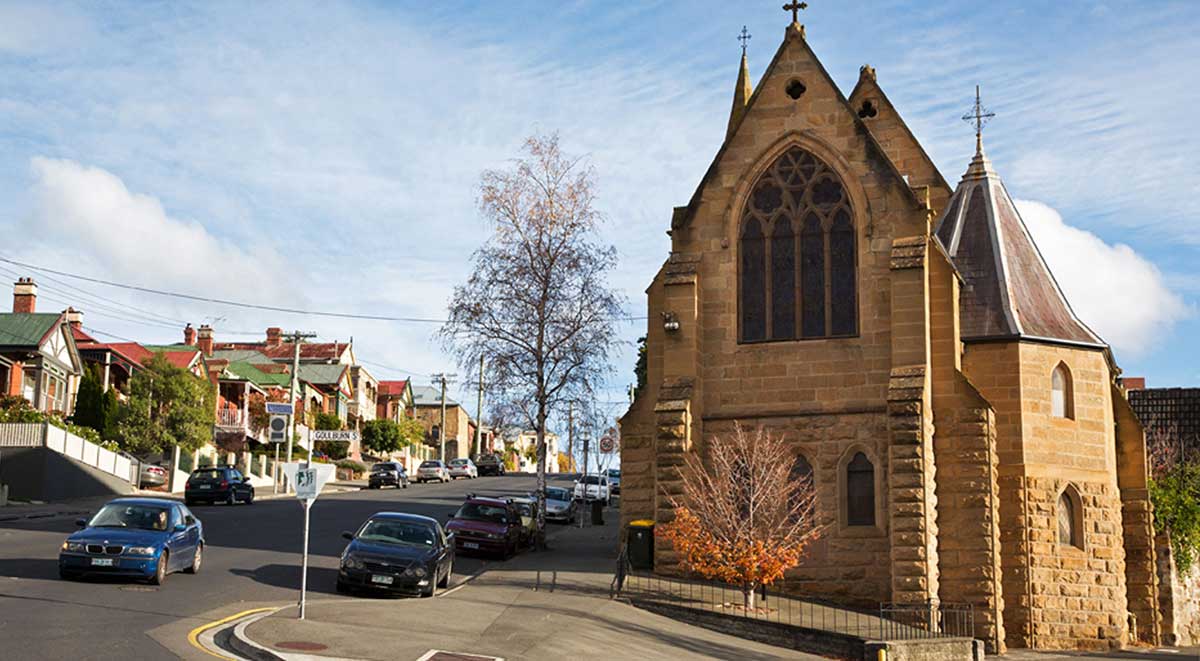
The inner-city suburb of West Hobart is located in the hills immediately west of the city centre. The area was first settled as a farming district, hosting poultry, dairy, hops, orchards and Chinese market gardens. Various industries have also served in the area, including a brickworks at the top of Arthur Street and coal mines below Summerhill Road. The side of Knocklofty Hill served as a sandstone quarry. Knocklofty is now a reserve maintained by the Hobart City Council. The area around Goulburn and Harrington Streets was once a red-light district.
Considered a 'working-class' suburb until the 1960s, West Hobart has become increasingly a popular inner-city suburb. Many of the houses in the area are older federation-era buildings, prized for their views of the Derwent River.

Knocklofty Reserve
A couple of minutes walk from the city suburbs of West Hobart and Mt Stuart, you're in native bushland that spreads across the slopes and peak of Knocklofty. The reserve has numerous walking trails, so you can vary the length of your walk from 10 minutes to 2 hours. The Summit Loop takes you past many of Knocklofty’s highlights. At the Frog Ponds, the Friends of Knocklofty Bushcare Group have rehabilitated a disused dam to create a wetland habitat. From various vantage points along the walk you can enjoy views across the city, up to kunanyi / Mount Wellington and down the Derwent estuary. Alternatively take the Mt Stuart circuit. With over 300 native plant species in this much-loved reserve, there is always something in flower. Access point: Forest Road entry of Knocklofty Reserve, or the lookout car park at the end of Mt Stuart Road.
Knocklofty Reserve walking map
History and Heritage
The evolution and development of West Hobart is, to a large degree, entwined with the growth of Hobart. A large part of what is now officially defined as West Hobart was once regarded as part of Hobart. The historic maps of the area reflect this close relationship. Over one hundred acres of land had been granted within West Hobart by 1826, much of it in the areas now known as West and South Hobart. The recipients of this land in West Hobart, according to the Land Commissioners’ Plan of Hobart, were as follows: William Shoobridge received twenty acres; J Simmons obtained ten acres; five acres were set aside for a church; and another five for a burial ground.
Larger and more isolated land grants within the area included forty acres to an early settler referred to as McKay, and eighty acres to a Mr Mason. Land grants were also received by Dr James Ross in 1827 and in 1831. These grants of twelve and 300 acres encompassed much of what is now the Knocklofty Park. Several large estates were formed as a result of these early land grants. ‘Caldew’ was one such estate. Established by John Woodcock Graves in 1861, the grounds extended from Cavell Street (where ‘Caldew’ house was built) to the area now occupied by Lansdowne Crescent.1 ‘Highfield Estate’ was another property established by a Hobart merchant in the early years. The grounds, according to Rowntree, were extensive and covered the area around Knocklofty Terrace.2 Hundreds of other, smaller, land grants were made at different times throughout the nineteenth century.
West Hobart started to develop into a residential suburb from the early years of the nineteenth century. By 1826, a town plan had been applied to a portion of the area now defined as West Hobart. This plan was an extension of an earlier grid plan of Hobart that was prepared by Surveyor James Meehan, under instruction from Governor Macquarie in 1811. The Land Commissioners, who prepared the town-planning scheme, also made specific recommendations regarding the future extension of the existing town. Their report concluded that: The whole of the Land... on the West side within the unconnected line - should be reserved for the future extension of the Town and only given in allotments for Houses and Gardens. This recommendation appears to have been adopted because, by 1839, the ‘west side’ was further planned out into streets and subdivided into allotments. The land in closest proximity to the centre of Hobart Town was first developed. This area, bounded by Harrington, Bathurst, Liverpool and Molle Streets, was particularly dense in urban development. Conversely, the land directly north of this, which rose steeply and was encompassed by Lansdowne Crescent, was coarsely subdivided and had only a sprinkling of houses.

George Frankland’s 1836 Map of Hobart
By 1839, the northern town boundary had been extended from Warwick Street to Arthur Street, and the eastern town boundary ran along Knocklofty Terrace (there is an old sandstone boundary post at the intersection of Knocklofty Terrace and Poets Road). The streets plotted in the 1826 Town Plan had been extended, and streets running through the northern part of the study area were introduced. Hill, Arthur and Adelaide (now Hamilton) Streets, Lansdowne Crescent, and Mellifont Street (which was located outside the northern town boundary) were just some of the streets created during this period. This physical expansion of West Hobart was underpinned by a steep rise in population within Hobart Town. The population of 6,000 in 1830 had become 14,000 by 1836. The 1840s brought little change to the area. While a few new structures appear on Sprent’s Survey of Hobart Town between 1841 and 1845, there appears to be no major new street formations.
There appears to have been a stagnation in development within the area in the 1850s, a reflection of the the depressive economic circumstances of the time. By the 1860s there was a definite increase in new development within area. The earliest established areas of West Hobart had become increasingly built-up, and the steeper areas to the north were further sub-divided and built upon. The area encompassed by Lansdowne Crescent and Hill Street (referred to as ‘Crescent Fields’ on earlier maps) had been intersected by two main streets (Petty and Allison Streets) by 1866.
Economic depression again gripped the settlement of Hobart in the 1870s, when the colony was left reeling from the after-effects of the gold rushes which had resulted in a substantial loss in population. However, the economy of Hobart was stimulated again in the 1880s by a mineral boom. As a result, residential building increased and the population of the newly formed electorate of West Hobart rose from 5,577 in 1881 to 8,598 in 18916. West Hobart had developed into a suburb and was officially recognised as such in 1885, when a government report described the area as a ‘suburban town’. Roads had been pushed further west, above Knocklofty Terrace. Forest Road, Salvador Rosa Glen Road and Poets Road were all extended past the old town boundary. Similarly, a network of roads had developed beyond the old town boundary of Arthur Street.
Residential building within West Hobart slowed in the 1890s due to another wave of economic depression. Hobart’s economy remained weak before 1914, although a building boom occurred in 1906. After 1914, a tram service was introduced to West Hobart. This underpinned much of the residential development within West Hobart at the time, especially along major transport routes such as Lansdowne Crescent and Hill Street. Many new subdivisions were created at this time, one of which was between Newdegate and Arthur Street. This was offered for sale in 1902, and was comprised of forty-six lots. The area had once been part of Providence Valley, a farm owned by the Shoobridge family.
Although Hobart’s economy remained slow, there were sporadic outbreaks of home building between the world wars. Homes were built throughout Hobart with finance provided by the Agricultural Bank and the Commonwealth War Services Homes Commission. The Hobart City Council also attempted to provide subsidised housing, and built nine houses within the Hamilton Street area in 1930. Land has continued to be subdivided in West Hobart, especially the steep area between Knocklofty Terrace and Knocklofty Park. Hillside Crescent, for example, was subdivided in 1953, while the area around Kirby Court was developed in the 1970s.
Architectural styles of West Hobart
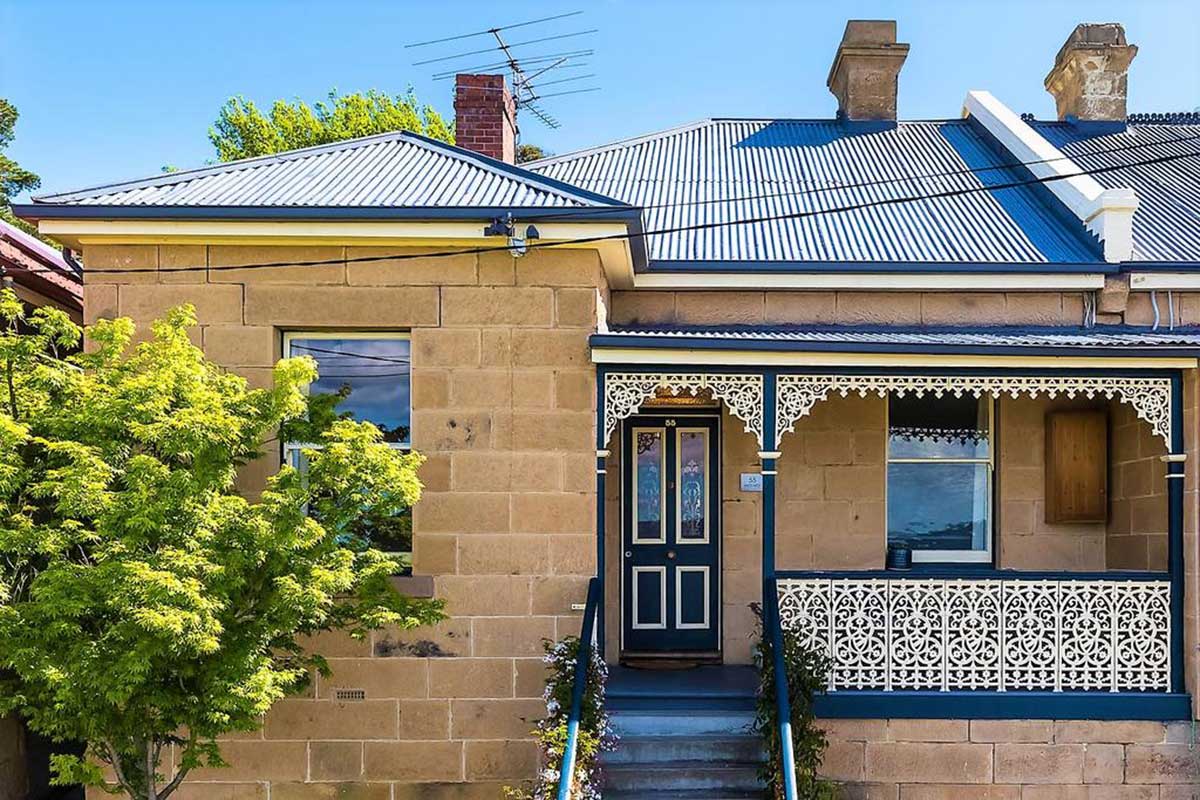
55 Lansdowne Crescent, West Hobart
During the early nineteenth century settlement of West Hobart, the Old Colonial Georgian style of architecture was dominant. Houses built in this style ranged from simple cottages, set on small to medium sized allotments, to larger, finely detailed homes with extensive grounds. A substantial number of these early houses survive. Smaller cottages from this period are generally located along Goulburn, Bathurst, Melville and Molle Streets, however, there are other early structures scattered along Forest Road, William, Frederick and Cane Streets, and Lower Jordan Hill Road. The larger, more substantial houses are mostly located on elevated land along Liverpool Street. However, there are other, more isolated colonial houses, such as Barton Vale which is located along Salvator Road; 11 and 81 Lansdowne Crescent, Wyndham, a c1830 house which was once the home of the noted colonial artist William Charles Piguenit. The small cottages appear to have been constructed of brick, while the majority of larger houses are of sandstone construction. There are some fine intact Old Colonial Georgian streetscapes in West Hobart, particularly along Bathurst Street between Barrack and Molle Streets.

'Caldew', Cavell Street
The majority of West Hobart's residences were constructed in the Victorian period. There are a small number of early to mid Victorian houses, most of which are small cottages that possess the familiar symmetry associated with the Georgian architectural style. Thought scattered throughout the ssuburb, there are clusters along Melville, Bathurst, and Goulburn Streets. More isolated structures can be found in Hill and Roberts Streets and within the Lansdowne Crescent area. More substantial mid Victorian structures exist, such as Caldew ( Cavell Street, c1861) which is located on spacious grounds between Faraday and Cavell Streets. The majority of these houses are of brick construction, however sandstone was the predominant material used in larger houses. The bulk of West Hobart’s Victorian houses were constructed during the late nineteenth century. As such, there is considerable architectural consistency throughout the area. The majority of houses are ‘decorated cottages’ with either symmetrical or asymmetrical plans. They are of weatherboard construction and are often decorated with iron lace and/or timberwork. Timber was the preferred construction material at this time due to advances in kiln-drying techniques in the 1890s. There were, however, large clusters of brick houses constructed, most of which would have been built of bricks produced at the Knocklofty Brickworks.

129 Patrick Street, West Hobart (Queen Anne)
There are a large number of Federation period houses in West Hobart, a considerable proportion of which are located along key transport routes. This residential ‘strip’ development was underpinned by the introduction of a tram service to the area in 1914. Basic weatherboard symmetrical and asymmetrical ‘decorated’ cottages continued to be a popular housing type during this period. Many of these cottages were decorated with Federation style elements such as: timber friezes — some in curvilinear form; timber balustrades with ornate motifs; fretwork; and leadlight panels. Larger Federation houses tended to be of brick construction, and were reflective of more traditional Federation period architectural styles such as Federation Queen Anne and Federation Bungalow. Federation weatherboard cottages were generally located on modest allotments, usually with a restricted outlook, such as those cottages positioned on the northern side of Newdegate Street. Larger, brick dwellings were specifically located on higher, more elevated land which embraced the views of river, city and mountain, such as 131 and 141 Patrick Streets.

18 Lochner Street (Functionalist)
The majority of Inter-War houses within West Hobart were probably built during the short periods of sporadic growth outlined earlier. Substantial parcels of land, many of which were in close proximity to major roads, were subdivided during this period. Key areas include the southern part of Lochner Street between Pine and Warwick Streets; and the land between Hamilton and Arthur Streets, intersected by Butterworth and D’Emden Streets and Dalton Avenue. Houses were also built in areas that had been substantially built upon by the late nineteenth century, such as Pine and Hill Streets, Forest Road and Lansdowne Crescent. Most of the houses built during this period were of brick construction. There were a small number of houses that were (and are) indicative of defined architectural styles, including Art Deco, Spanish Mission, Californian Bungalow and Functionalist.
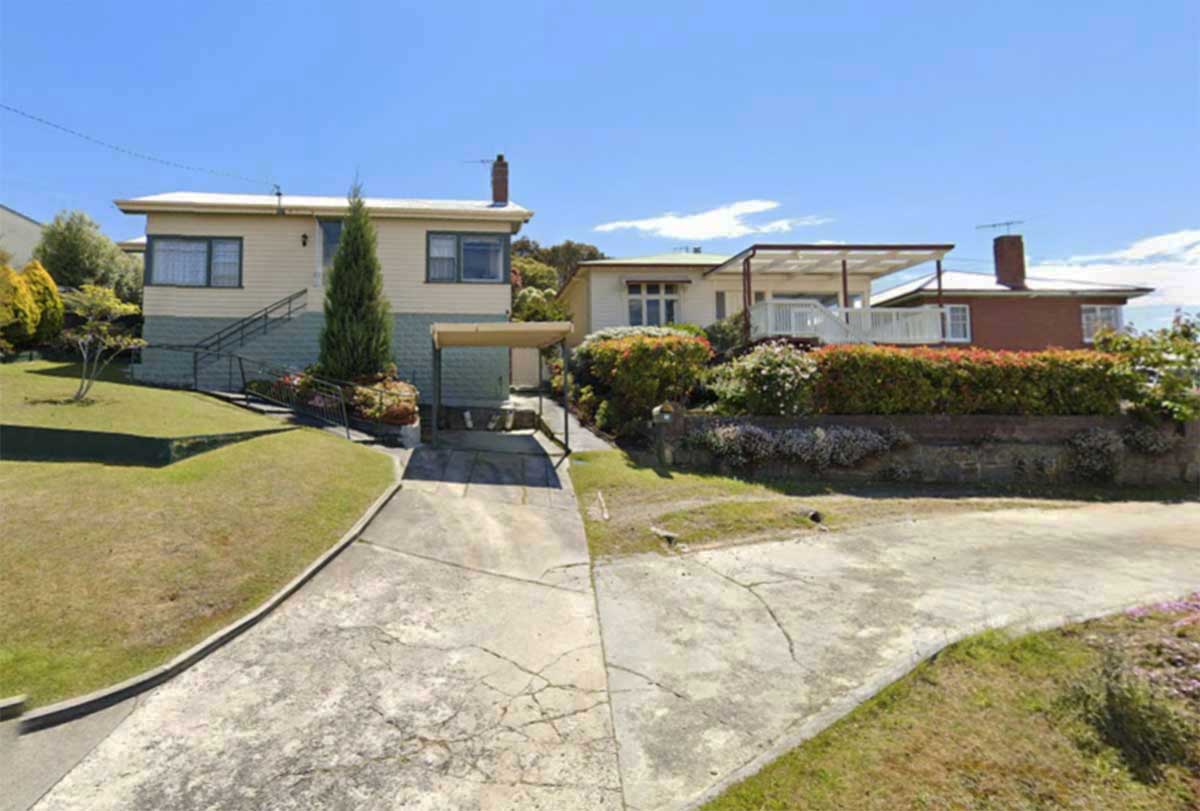
28 and 30 Poets Road, West Hobart
While the majority of Inter-War homes were of brick construction, there were groups of weatherboard houses built, especially along Liverpool Street and Poets Road. Most of these houses were austere. They were square in form, often had a simple porch and had large casement windows without the elegant leadlighting evident in Inter-War structures.

12 Summerhill Road, West Hobart
Houses built within the Post-War period tended to be part of large subdivisions, rather than infill elements. Steeper land in the west and north was built upon during this time. Major subdivisions included Rossendell Avenue in 1948, Elaine Court and Kennerley Street. Major roads, such as Summerhill, Poets and Forest Roads, and Liverpool Street were pushed further west and the surrounding land was subdivided. Houses built within major subdivisions tended to be uniform in architectural style and materials.

40 Knocklofty Terrace
Most of West Hobart’s late twentieth century housing stock is located on elevated land to the west of Knocklofty Terrace. Many of the subdivisions within this area, such as Kirby Court, date from the 1960s and 1970s, and the homes there reflective of this. The majority of houses are two-storey weatherboard or brick.

Hill Street Reservoir
Water Supply
West Hobart’s early water supply was taken directly from numerous mountain streams that flowed through the area. These included: the Hobart Rivulet, which runs along the southern boundary of the suburb; McRobies Gully, located on the southwestern slopes of Knocklofty; and the Salvator Rosa Glen Creek; Ross Rivulet; and Providence Gully Creek which meander down the eastern slopes of Knocklofty. Water was pumped and/or carted to be used for domestic purposes. In the 1830s a circular, brick conduit was constructed along the Hobart Rivulet. The Town Tunnel, as it was called, was subsequently lengthened, and soon developed into a network of underground pipes that serviced Hobart Town. By 1853, this water reticulation system was extended to part of West Hobart via Harrington and Goulburn Streets.
Much of the suburb was supplied with reticulated water by 1887. From the 1840s reservoirs were built at nearby locations to provide a stable and constant water supply to Hobart Town and its suburbs. In 1883 a reservoir was constructed in Hill Street where the intersection lies at Faraday and Cavell Streets. This was connected to a storage reservoir via a bridge across the Hobart Rivulet (Gore Street) which carried a ten inch water main beneath its deck. The Hill Street Reservoir is still in use and is now classified as a reserve supply and fire-fighting back-up. Other reservoirs located within West Hobart include the Forest Road Reservoir, which is located at the western end of Forest Road, in the Knocklofty Reserve. It is of concrete construction with a lookout. This reservoir ceased to function in the late 1970s. A third reservoir, which is of concrete construction,23 is located at the western end of Arthur Street (built c1950). There is a fourth reservoir, also built of concrete, that is located within the Knocklofty Reserve, to the west of Fielding Drive.
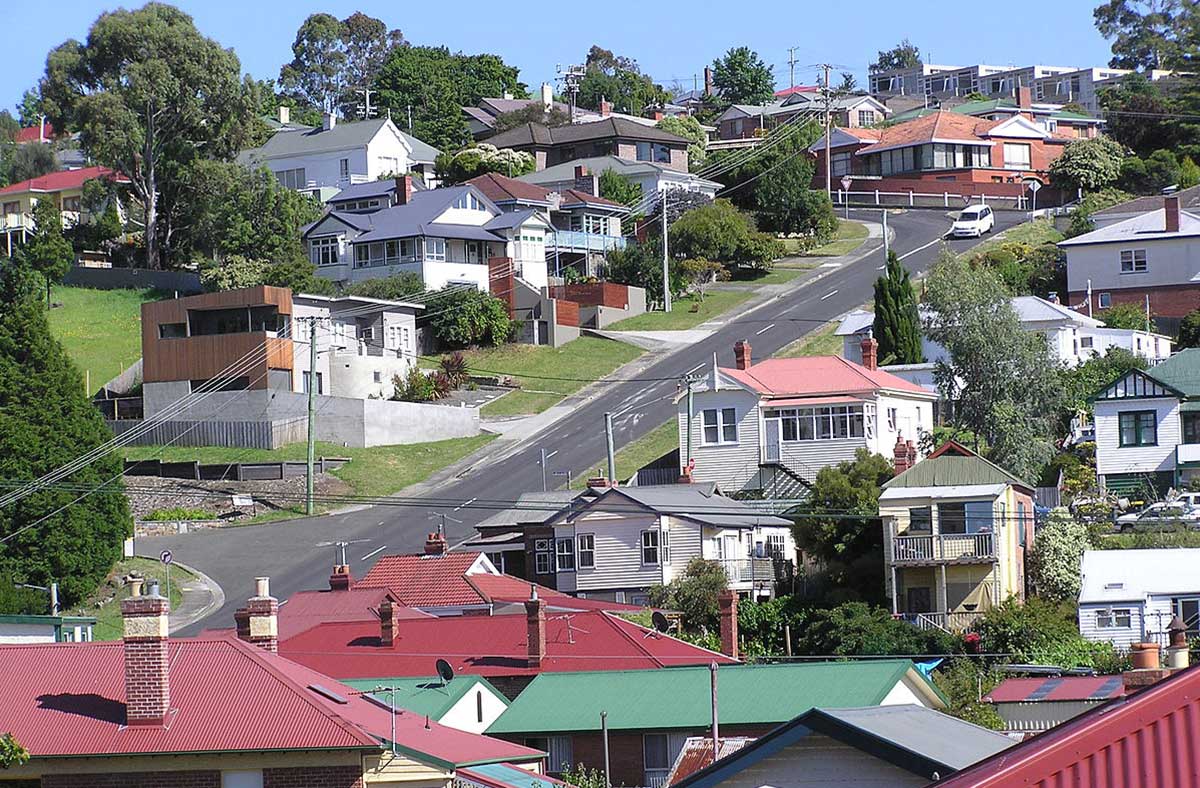
Mellifont Street, West Hobart
Roads
West Hobart has some of the steepest roads in Hobart; Mellifont Street is just one example. Throughout the nineteenth century, roads within the area were unsealed and muddy, conditions that prevailed, according to photographic evidence, at least until the turn of the century. It appears a network of lane-ways developed. These are evident on historic maps of the period and, indeed, some still exist. The main function of these lane-ways was to intersect large blocks of land in order to provide access to the backyards of houses. This access was essential, especially when the pan system was introduced, as most privies were located in backyards. Some early road fabric, such as sandstone kerbs, remains along a few streets within the area.
Transport and Communication
Walking would have been the major mode of transport for the majority of the population of West Hobart in the early years of settlement. The area initially settled (south-eastern section of the detailed study area) was in close proximity to central Hobart, and was originally regarded as part of Hobart Town. When vehicular transport was introduced, including trams, buses and motor cars, the area grew and developed into a suburb.
Horse-drawn Carts and Coaches Horse-drawn carts were the major form of vehicular transport used in West Hobart in the nineteenth century. Although carts were owned by many individuals, there were public coach services which departed from central Hobart and conveyed paying customers to locations within West Hobart. In the 1880s and 1890s, for example, Ward’s Omnibuses and Porthouse’s Omnibuses ran a service from Elizabeth Street to Lansdowne Crescent.

Tram Stop No. 114, West Hobart tram terminus, located near the bottom of Mellifont Street hill, cnr Summerhill Road
Middle distance suburbs, such as West Hobart, were largely formed in the era dominated by public transport in the form of the tram. Until the extension of tram routes into West Hobart in 1914, much of the area remained inaccessible for most people. A tram service had been operating in Hobart since 1893, and in 1913 the privately run service was acquired by the Hobart City Council. Soon after, the service was extended and improved with several new lines, including the West Hobart Line, opened in the 1900s. The West Hobart tram service ran from the Hobart Railway Station, along Liverpool, Goulburn and Hill Streets, around Lansdowne Crescent, and along Hill Street to Arthur Street. It was extended in 1916, and ended at the intersection of Newdegate and Mellifont Streets. The route was hilly and had many steep corners, which hindered the use of double deck cars. One distinctive feature of the route was the ‘Y’, a section of track at the intersection of Cavell and Goulburn Streets where trams had to reverse in order to negotiate the sharp bend into Cavell Street. This precarious feature was removed in 1931.
West Hobart tram services were closed in 1958, and immediately replaced with trolley buses that followed the same route. Motor powered bus services operated by the Metropolitan Transport Trust were introduced in the early 1960s. Buses are now the only form of public transport operating within the suburb.
Motor cars first appeared in Hobart in the 1890s, and numbers increased after 1900. As with other forms of transport, the motor car required certain types of infrastructure, including reasonably formed roads, petrol stations and, of course, garages. Motor cars had an important impact on West Hobart for, until the general advent of the automobile, hilly localities such as those in West Hobart must have been at a disadvantage compared with nearer or more easily accessible areas. It is interesting to note that a number of the nineteenth century houses in West Hobart have had garages, many of which are visually intrusive, tightly positioned onto their allotments.
Telecommunications
A Telephone Station was located at the corner of Upper Goulburn and Frederick Streets, West Hobart. The structure was listed in Directories of the 1890s as occupying 170—178 Goulburn Street and was described as a Telegraph Office, the manager of which was a Mrs Raynor. It continued to function as a Telecommunications centre until at least the 1930s. A Post Office operated from the corner of Hill Street and Lansdowne Crescent from the 1940s. The West Hobart Post Office still operates from this site, but is now housed in a large corner shop, at 12 Hill Street.
Industry and Commerce
A variety of industries and commercial enterprises operated within the West Hobart area from the early nineteenth century. In the early years of settlement, agriculture was a major activity within the district. In the later years food and beverage, building and furnishings, clothing and textiles, transport, mining and other miscellaneous industries operated within the district.
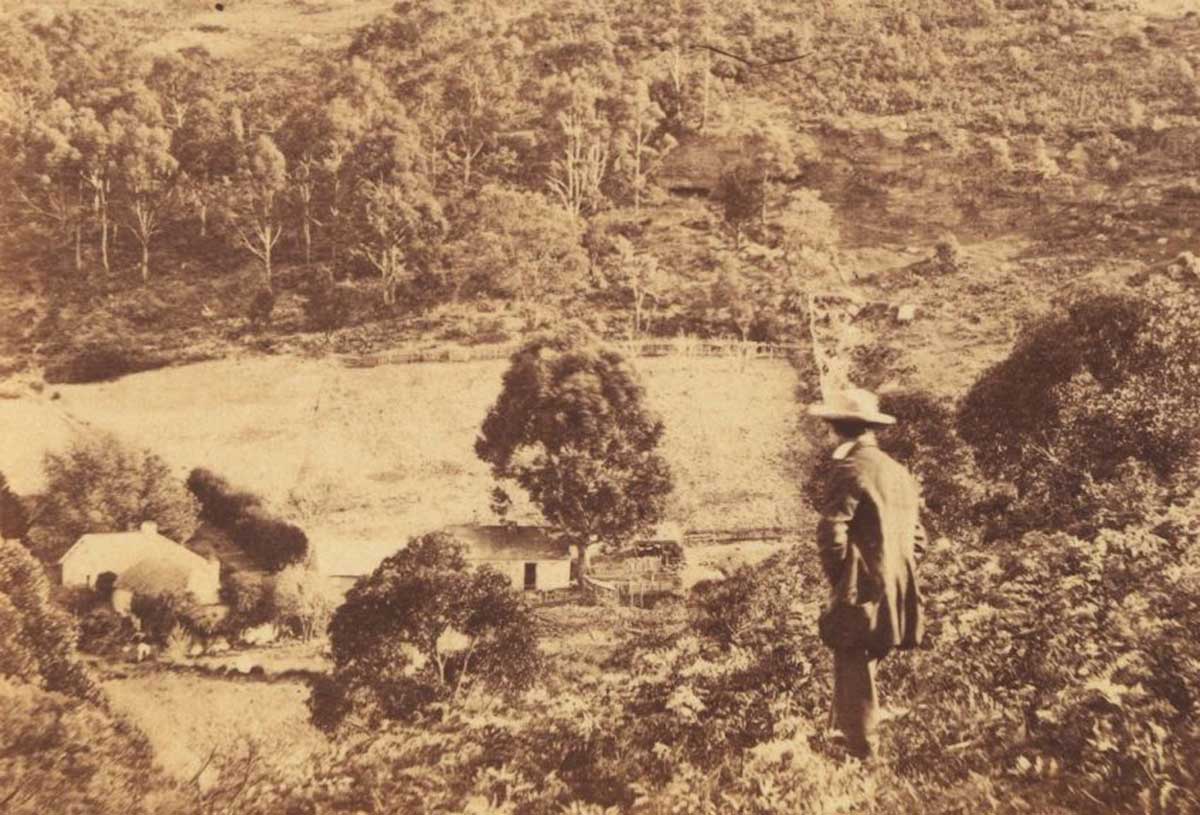
Agriculture
Farms were established throughout the highly fertile lower slopes of Knocklofty from the 1820s, and a wide variety of crops were grown. One of the first farms was Providence Valley, established by William Shoobridge on land granted in 1822. Hops (first harvested in 1825) and potatoes were the main crops cultivated on this farm. Wheat was also grown in the extensive fields of Highfield Estate. By the 1860s, market gardens had been established throughout the area. Extensive Chinese market gardens encompassed what is now Upper Newdegate Street by the 1900s. Similarly, orchards were also established in the early years and operated well into the twentieth century.
Dairying
Dairies were dotted around the West Hobart area throughout the nineteenth and early twentieth centuries. Milk was usually delivered twice daily in summer, from the small dairy farms which surrounded the city. One of the early dairies operating in the area was Dunn’s Dairy, which was located in Forest Road and is thought to have operated some time between 1820 and 1860. Dairies were still operating in West Hobart in the early twentieth century, particularly in the area around Arthur, Mellifont and Browne Streets, which were not substantially built-upon. Rossiter’s Dairy was located in Browne Street in the 1920s and a dairy operated near Arthur Street in the 1930s. Milk deliveries were made to the immediate area of West Hobart and to places further afield such as New Town, Sandy Bay and the City.

Site of Somerset Mill, 44 Molle Street, West Hobart
Baking and Beverage Manufacture
A number of bakers operated within the area from an early period. It was an industry that was easy to get into as, according to Scripps, it required little capital beyond the erection of the bakehouse or ovens, and the work of the bakery could be carried out by one person. From 1824 Rollston’s Bakery operated from 45 Goulburn Street (presently Eumarrah Health Food Shop). The business changed hands in the 1830s, 1860s and 1880s and ceased to operate as a bakery around 1900 when the premises became a grocery shop. The Somerset Mill, which was a steam flour mill, was located at 44 Molle Street. This business operated from 1809 to the 1880s, and had the capacity to produce thirty tons of flour per week. There was at least one beverage manufacturer operating within the district. The Old Malthouse or Brewhouse functioned in the 1840s, and was located at 173 Melville Street.
Quarrying
A number of industries were established in West Hobart that were vital to the physical construction of the settlement of Hobart. From 1916 a lime quarry and kilns were in operation within the West Hobart area. This industry was established by the Colonial Government and was located on sixteen acres of land between Browne (formerly Quarry Street) and Lochner Street. In 1832 the complex was leased to various private landholders until its closure in the early 1860s. Richard Shoobridge, farmer of Providence Valley and the son of William Shoobridge, made a great success of the business during the 1840s and 1850s. The site was subdivided in 1864.
There are two large disused sandstone quarries located at the western end of Arthur Street on the slopes of Knocklofty. At least one of the quarries had been successfully worked during the 1830s, according to a report by the Hobart Town Courierin 1838. The sandstone from these quarries was used in the construction of a number of Hobart’s prominent buildings including St Mary’s Cathedral, the Town Hall, the Post Office, Holy Trinity Church and various bank buildings. They were locally known as the ‘Stringybark Quarries’, and produced sandstone ranging from yellowish brown to pale grey orange in colour. The quarries were worked up until 1976.
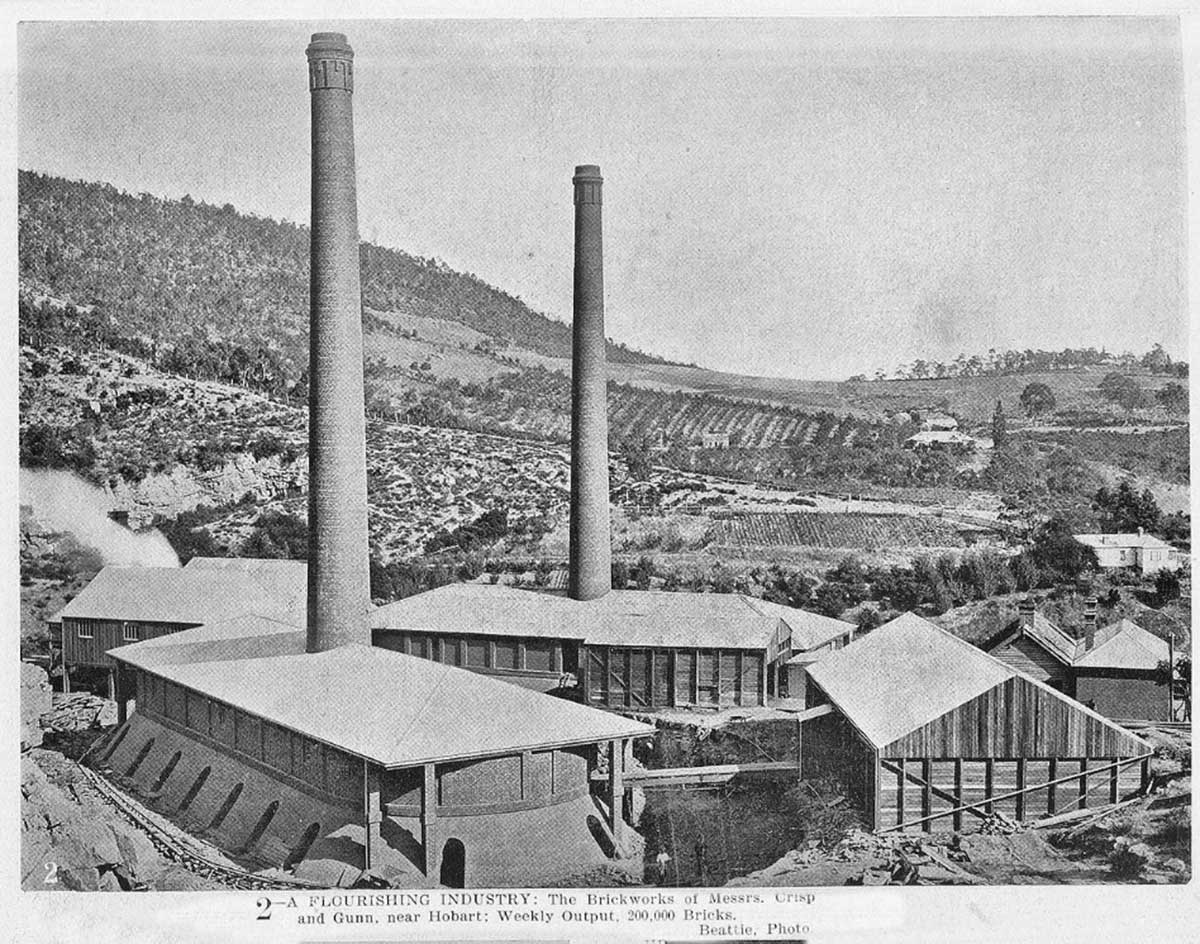
Crisp and Gunn Brickworks
Brick-making
In the late nineteenth century brickworks were established near the two Knocklofty quarries. The works were run by Rippon Shields, who had previously operated the sandstone quarries. Shields introduced innovative machinery to the works, including a horse-powered roller, pugging mills, and a mechanical brickmaker. By 1883 three kilns had been cut into the rock of the quarry site, which were capable of holding 26,000, 35,000, or 60,000 bricks respectively. By 1900 the brickworks, one of only a few large brickworks operating in Tasmania, was run by WH Cheverton, a building contractor. In 1905 the works were taken over by G. & T. Gunn (later known as Crisp & Gunn). Modern electric machinery was installed, and by 1914, 200,000 bricks were being produced each week. Operations at the site continued until 1965 when the deposit was exhausted. In November, 1968, two tall chimney stacks at the top of Arthur Street were demolished. The site has been sub-divided and built upon.
Clothing and Textiles
There were numerous clothing and textile factories operating in Hobart in the 1880s and 1890s. One of these, a woollen mill, was located in Molle Street, West Hobart. This mill was constructed by Johnstone Brothers in 1898, who established the Tasmanian Woollen Manufacturing Company in 1883, and had leased the nearby old Artillery Brewery in Gore Street, South Hobart. In the 1890s the industry went through a boom period, and this prompted the construction of the Molle Street factory. The company made an array of woollen goods such as tweeds, blankets and shawls. Business flourished during World War I when the mill made countless flannels and blankets for the Australian Infantry Forces. Operations slumped in the 1920s and the factory was closed in the 1930s.
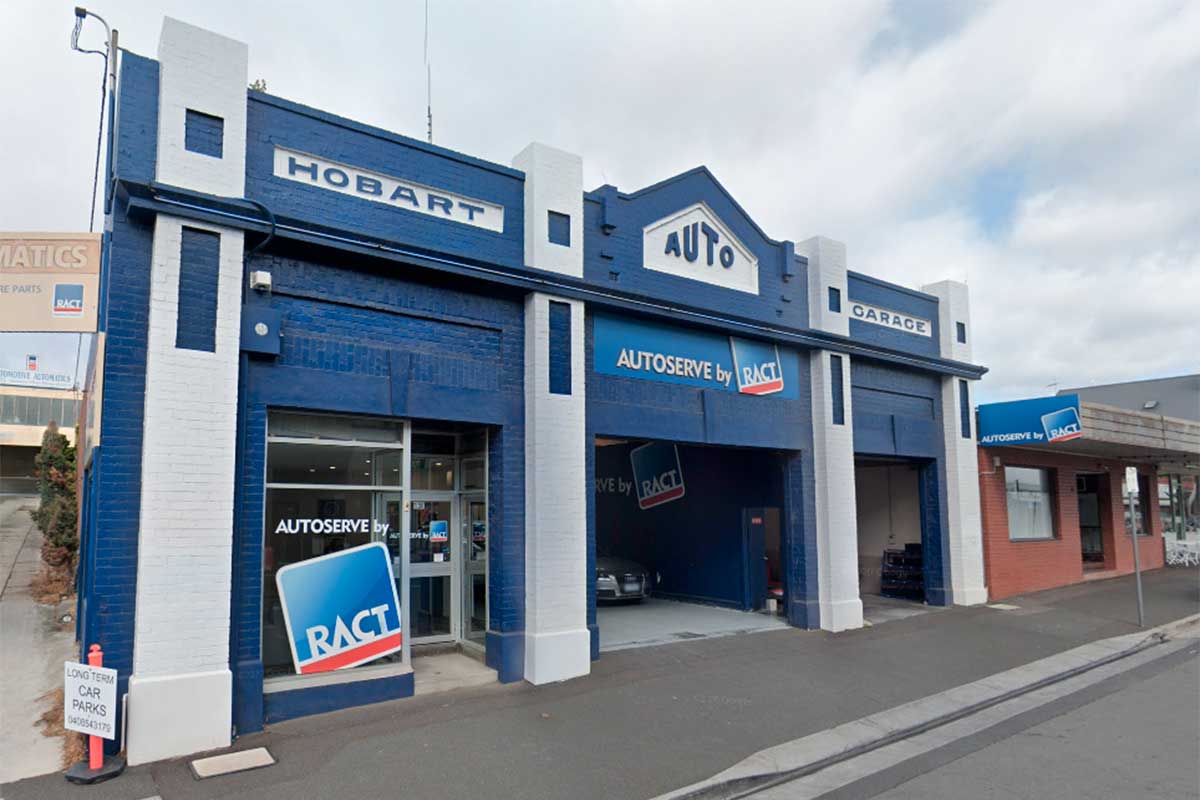
136 Harrington Street
Transport Industries
Coach works operated within West Hobart in the 1890s. Cramp Brothers’ Coach and Carriage Buildings, established in 1892, was (and still is) located at the corner of Harrington and Melville Streets. The firm, according to Scripps, made a wide range of vehicles, manufactured using local raw materials, and exhibited them widely. The firm still operates under the same name, but now functions as a vehicle bodyworks. Another coach works, known as Burrows’ Coach Works, operated at 127 Melville Street. In 1925 a motor garage was established at 136 Harrington Street. The Hobart Auto Garage, as it was originally known, was purpose built by a Mr Reardon and Mr Thompson who were motor engineers. A year later the business was expanded to include Loane and Loane, motor car salesmen. The building continues to function as an automotive repair garage.
`
Other Industries
Other early industries established within the area included: rope-making, which was principally carried out in the 1830s by David Ramsay at 165 to 167 Melville Street; timber-getting, the material for which came from Knocklofty between the 1840s and 1860s; and coal mining, which was reported to have taken place in an area below Summerhill Road. Later industries established within the area include a fish factory, which was (and is) located in Browne Street. The factory was established by Harold Watt, fish merchant, in 1945, and is now used as a freezer food store for H Watt — Frozen Food Distributors.

St Mary's Catholic Cathedral, Cnr. Patrick and Harrington Streets
Roman Catholic Church
The religious needs of the population of West Hobart were attended to from the early years. In 1828 the Roman Catholic Church received a land grant of two acres in the vicinity of Harrington, Brisbane and Patrick Streets, for a burial ground. The cemetery was enclosed by sandstone walls built in the 1830s (parts of which still survive), and held the remains of over 300 people at the time of its closure in the 1870s. An additional five acres were granted in 1831 for a Chapel, which was later built in 1833, located at the corner of Barrack and Brisbane Streets. When the land was granted to the Church, it was regarded as being‘most inconvenient and indeed almost inaccessible at certain seasons’. Nevertheless, the Catholic Church went on to develop the land. The first St Mary’s Cathedral was completed in 1866, then closed in 1876, and later dismantled due to structural defects. The cathedral that presently occupies the site was completed in 1881, and designed by notable architect Henry Hunter. In 1880 the Bishop’s Palace was constructed, as well as St Peter’s Hall, and various other Roman Catholic School buildings.
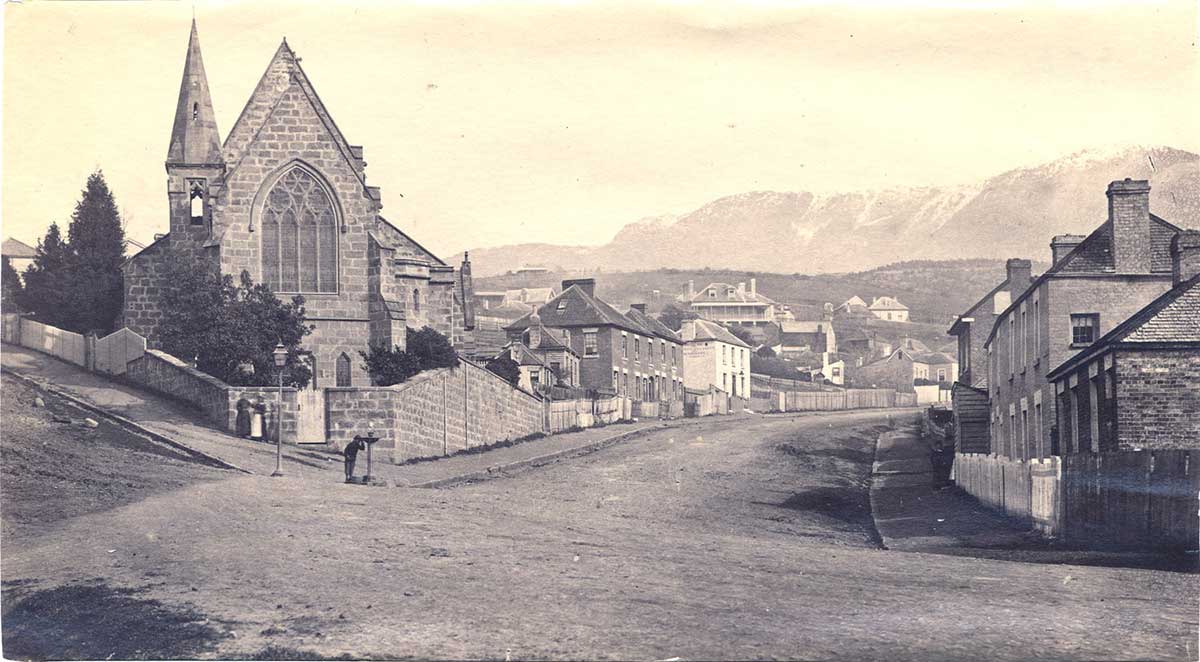
St John the Baptist Church of England, Goulburn Street, West Hobart
The Church of England
The Church of England was also delivering pastoral care during the early years of the suburb’s development. In 1844 the parish of St John the Baptist was formed. The year after, a parish hall was erected on the southern side of Goulburn Street. This served as a church, a Sunday school, and a day school. As the population increased within the parish area, an appeal for funds for the erection of a church was launched in 1852. The church was completed in 1856 and consecrated that same year. Other buildings were added to the parish as it grew, such as a rectory and organ in 1864, a scout room in 1870, a new church organ in 1880, major additions and alterations to the church in 1902, and a kindergarten in the same year.
The church itself has long been a landmark of West Hobart, with many considering it the ‘gateway’ to the suburb. It was closed in 1997 when the parish of West Hobart was joined with the parish of St Peter’s Sandy Bay to form the Bay West parish, and de-consecrated in September 1998. St John the Baptist Church, where many members of the local community were baptised or married, has been an integral part of the West Hobart community for 146 years. St Michael’s and All Angels Church and Hall, which are located in Franklin Street. These structures were built in the 1920s, probably to accommodate the needs of the rising population of the area at that time. The parish was established in 1919 but was amalgamated with St John the Baptist Anglican Church in the late 1970s. The Church has been sold since its closure.
More

Chalmers Free Church
Other Churches
Other churches known to have operated within the suburb include the Chalmers Free Church, the Church of Christ and the Seventh-Day Adventists Church. The Chalmers Free Church, which was opened in the 1860s, stood at the intersection of Harrington and Bathurst Street, It was demolished in 1955 by the Neptune Oil Company to allow for the construction of a modern ‘American Style service station’. The Church of Christ was built around 1924. It was located on the eastern side of Hill Street near the intersection with Petty Street and continued to function at least until the late 1940s. In 1971 the church became a Ukrainian Orthodox Church — St Volodymy, and was consecrated by Archbishop Andrew of Edmonton, Canada on 28 November 1971. The church has since been de-consecrated and is currently occupied by Contrast Photography. The Seventh-Day Adventists Church, which was built in the late nineteenth century, was located at the corner of Warwick Street and Watkins Avenue. The simple weatherboard church is currently known as the Christadelphian Assembly Hall.
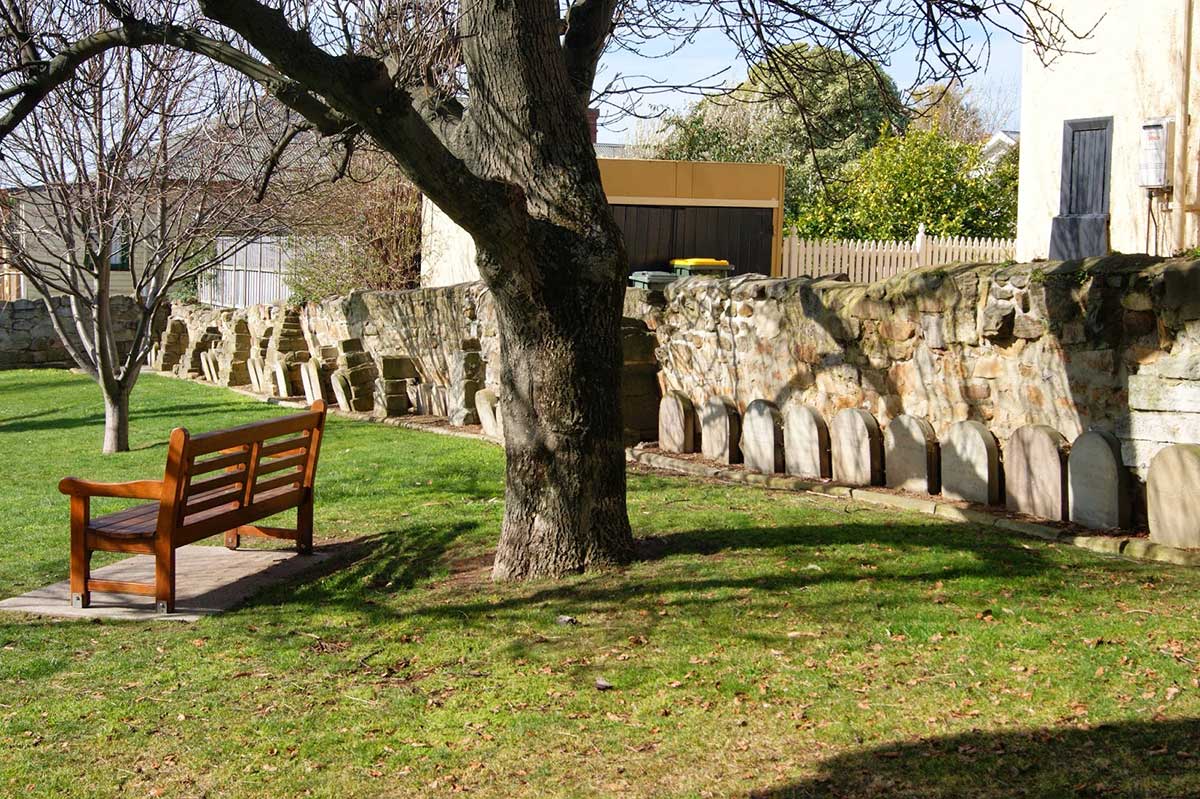
Friends Park, site of Friend’s Cemetery, Mellifont Street
Cemeteries
Burial grounds within the suburb were established by various religious communities from the 1820s onward. The land for these sites, which were originally chosen because they were located in ‘outlying areas’ within the town’s limits, was granted by either the government or private landholders. As the suburb of West Hobart grew, these burial grounds became surrounded by urban development. The cemeteries that were located within the area included: the Friend’s Cemetery, Mellifont Street, established 1836, closed 1912; the Jewish Cemetery, located off Harrington Street between Patrick and Warwick Streets, established 1828, closed 1872, and now the site of Windsor Court Flats; the Roman Catholic Cemetery; and the Wesleyan Cemetery, located on half an acre of land at the corner of Hill and Hamilton Streets, established 1840, and closed in 1872. Some of these burial grounds have been built upon, and others are now recreation grounds.
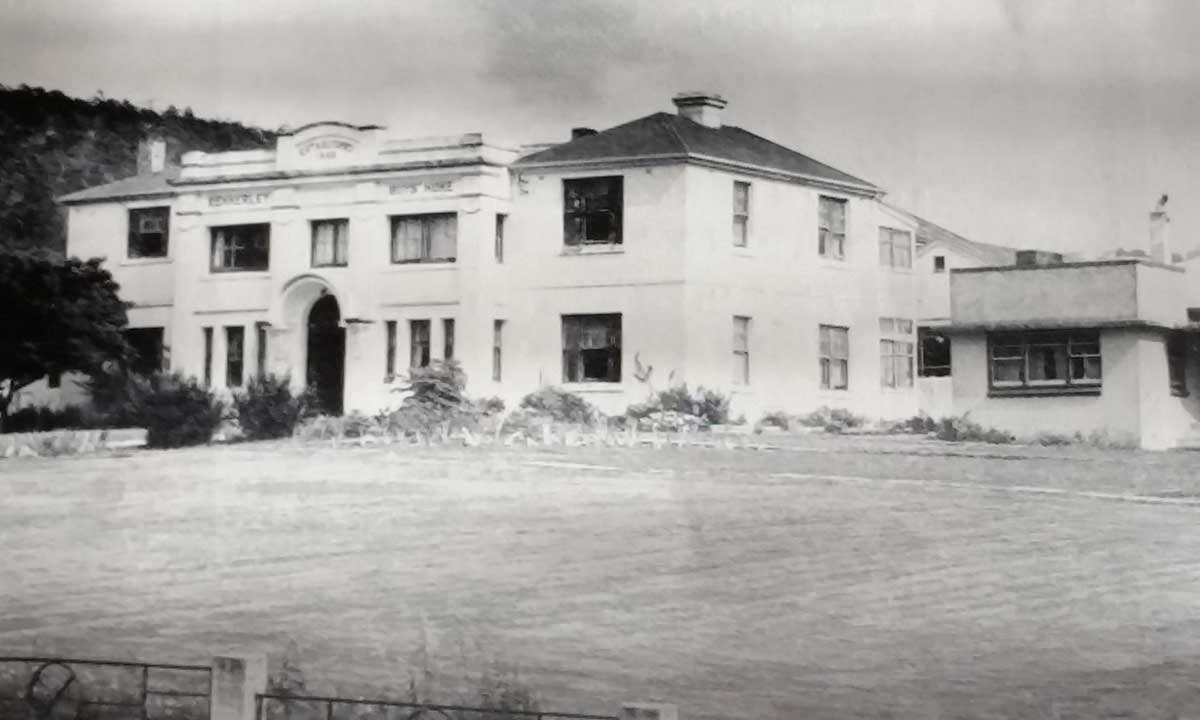
Kennerley Boys Home, 1962
Charitable Institutions
Philanthropy has long been alive in West Hobart. A number of charitable institutions, including the Kennerley Boys’ Home and the Salvation Army Mothers’ Home, were established in the late nineteenth century. The Kennerley Boys’ Home was established in 1867 after a bequest from Alfred Kennerley, who gave land and buildings for the boy’s home, which was to function as a refuge or ‘Industrial School’ for orphans and boys from broken homes. In later years, the home accepted boys who had committed minor offices. The home fronted onto Hamilton Street, and was located between Arthur and Hill Streets. The complex was comprised of a large two-storey sandstone house and sports and recreation grounds, and in 1951 a hostel was opened to assist boys who had been released from the home to adjust back into the community.
The institution operated for over one hundred years before being forced to close in 1970 due to financial problems. According to Goodrick, the home was the only one of its type in southern Tasmania, as it operated without support from institutional and religious bodies, relying instead upon public support. The modern complex of AA Lord Homes now occupies the boys’ home site. The Salvation Army Mothers’ Home, which was located in Lansdowne Crescent, was opened in 1897 to provide care and ‘alleviate distress’ for single mothers and married women in ‘poor circumstances’. Inmates were expected to work, doing laundry or fancy work, to help raise revenue for the home. Their babies were commonly adopted out, and outside employment was arranged for the young mothers after the birth of their babies. The home, according to The Cyclopedia of Tasmania, 1931, provided“a means whereby they [the inmates] can rise again, and regain their lost prestige in the community.” In the 1920s the home functioned as a private hospital and in 1962 it became known as the Elim Maternity Home. The maternity home closed in 1973 (the last baby was also adopted from the home in December of that year).
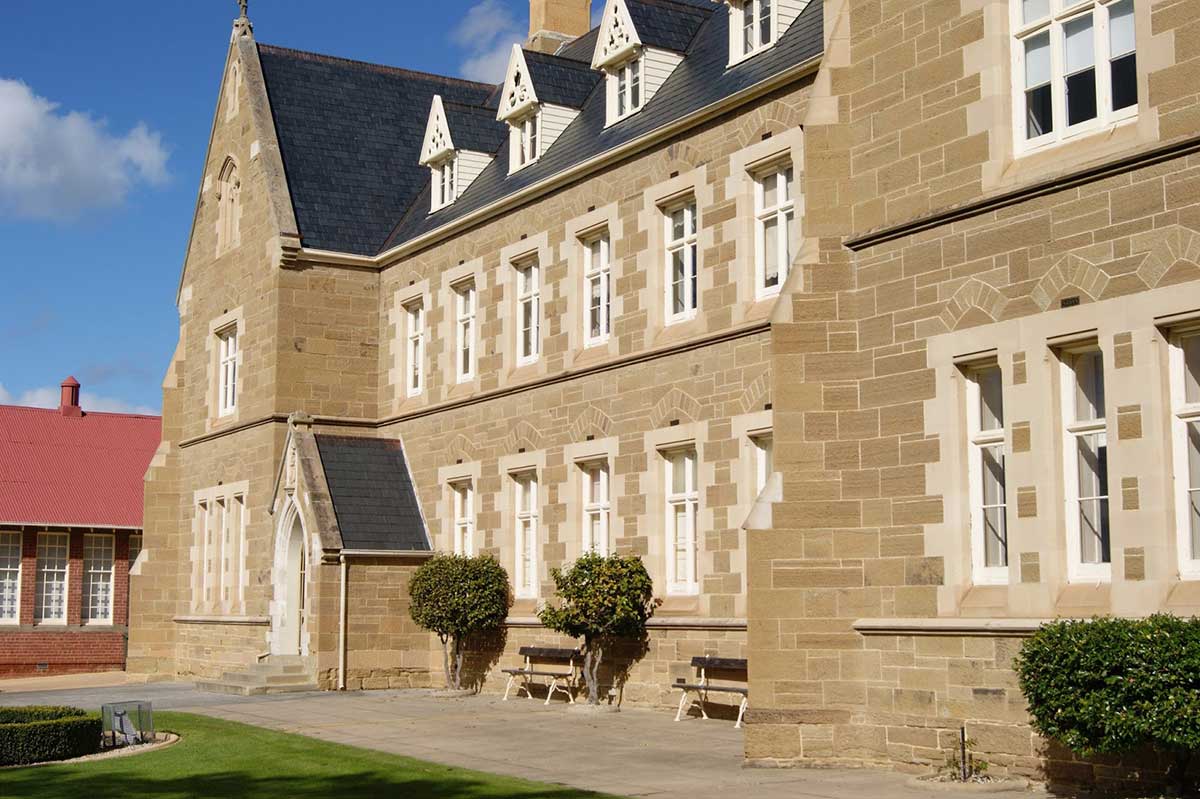
Lansdowne Crescent School
Education and Recreation
The first schools attended by the children of West Hobart are likely to have been privately run institutions, as government schools were not established within the area until the 1850s. It is also likely that poor children living within West Hobart (especially the area around Goulburn Street) attended Ragged Schools, the closest of which was in Watchorn Street (opened 1854). These schools provided free education and were funded by public subscription. Various religious communities also established schools from the 1850s.
The Goulburn Street Primary School was the first public school established within West Hobart. It was built in 1852. The school was located in the most depressed area of West Hobart, notorious for the number of public-houses and brothels. Nevertheless, by 1900, around 450 students attended the school. In 1942 it burnt down, but was re-built and opened a year later. The other public school established within the suburb was Lansdowne Crescent School, which was opened in 1916, after a sudden rise in the population of the area, sparked by the establishment of the tramway. It was opened as a model two-teacher school, attended by about ninety students.
By 1931, the number of students had increased to 400. The West Hobart Recreation Ground was adjacent to the school and provided the space where school sports were played. The school, as the Cyclopedia of Tasmania, 1931 describes: ... "[occupies] a commanding position on the slope of the hill above, from which a magnificent view of Hobart‘s commodious and beautiful harbour may be obtained. ... Being situated in a pleasant residential area, the school caters for a fine type of scholar..."
A number of schools were established by the Roman Catholic Church including: St Mary’s College and St Columba’s School in 1868, which were both under the governance of the Presentation Sisters; St Peter’s School in 1893, which was founded by Thomas Mitchell but, after his death in 1915, was taken over by the Christian Brothers; and St Virgil’s College in 1911 which was established by the Christian Brothers. St Mary’s College was located next to the Cathedral. The school received pupils (girls only after 1911) from more affluent families, and provided a full scholastic course. Alternatively, St Columba’s School provided more basic education and was generally attended by poorer children. The two schools merged in 1957.
St Peter’s School was originally named St Mary’s Boys’ School and educated boys of primary school age (girls were accepted for two years in 1908 and 1909). In 1922, under the direction of the Christian Brothers, the school became known as St Virgil’s College Primary Department. It was only in 1939 that the name was changed to St Peter’s. The school was again merged with St Virgil’s College in 1996. St Virgil’s College was built on the site of the old Roman Catholic Cemetery, and functioned as a Catholic primary and secondary school for boys. It is now a co-educational college.
rrun by the Salvation Army, operates as a hostel.
As well as the ‘Cathedral Schools’, numerous privately run colleges and finishing schools operated at varying times throughout West Hobart. One such institution was Queen’s College, which was originally based in ‘Minallo’, a grand old house located in Minallo Avenue. The college was housed at ‘Minallo’ during the early twentieth century, but later moved to a hall in Arthur Street and closed in 1943.
Clubs and Pubs
The people of West Hobart engaged in a range of outdoor and indoor recreational activities. Various sporting clubs were formed such as the West Hobart Football Club in 1945, the Derwent Bowls Club in the 1900s, and Cricket Teams in the 1900s. There were tennis courts located in Hamilton Street and Salvator Road and the slopes of Knocklofty provided an ideal playground for the children of the district. Swimming was undertaken in large ponds at the Brickworks complex, and children took great delight in sliding down the slopes of Knocklofty on home-made sleds. Public Houses also provided an essential form of indoor entertainment. They were thought to cater for the ‘lower classes’, as they were typically venues for unsavoury activities such as cockfights, dogfights, skittles, gambling and dancing.
The main concentration of public houses in West Hobart was in Goulburn Street, with a few operating in Barrack, Bathurst and Brisbane Streets. Many of these were established in the early years of settlement. In 1840, for example, there were twelve public houses operating within the area, eight of which were located in Goulburn Street. The Marquis of Hastings Hotel c1847 is the only public house still operating within the suburb. A community hall was built in Lansdowne Crescent in 1880. The hall was built by the farmers of the district who formed a group known as The Institute. The hall has been the venue for a wide range of activities such as boxing, badminton, judo tournaments, meetings of the West Hobart Progress Association, and various social occasions

Caldew Park
The Lansdowne Crescent Park was the first established as it is referred to in Postal Directories of the 1890s, and was (and still is) regularly utilised by the local community. The Friends Park, formerly the Friends Cemetery, was used as a children’s playground from 1926. In 1937 the whole area was transferred to the Hobart City Council (HCC) under the condition that the ground would be maintained as a park. The site was declared a city recreation ground in 1941. The John Doggett Park was established by the HCC in 1981, and is located on the site of the old limekiln quarry reserve. Facilities at the park were re-vamped in 1995. Caldew Park, which is located on the site of an old quarry, was opened in the late 1940s, and was also upgraded in 1995. Facilities were overhauled and play equipment (namely the large timber train that dominates the park) was repaired and installed.

Knocklofty Park
Knocklofty Park is located at the western boundary of West Hobart. The 122 hectare park is comprised of mostly bushland, with some cleared areas. The park extends from Mount Stewart Look Out in the north to Forest Road in the south. While most of the land was acquired by the HCC in the 1940s, smaller parcels of land have been added to the park from the 1950s. In 1979, for example, the Forest Road Reserve was incorporated into the park. Knocklofty has been enjoyed and utilised by residents of West Hobart for a long time. The land has been used for timber-getting, quarrying, rough grazing and for hunting, most of which was carried out by successive owners during the nineteenth century. The area has also been used for recreation for many years.
Source: West Hobart Heritage Review, prepared for the Hobart City Council, June 2000.
The above article is a summarised version of part of the Heritage Review. The review itself includes more detailed information and is the perfect companion for anyone wishing to do a more detailed study of West Hobart's history and heritage, particularly if researching the history of a particular property, street or area.
West Hobart Heritage Review, prepared for the Hobart City Council, June 2000
